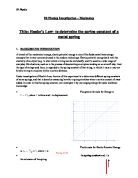Physics Lab Report:
Hook's Law
Done By: Izzat Sharif
IBDP/11 (A)
Physics HL
Aim: - To investigate Hook's Law (The relation between force and stretch for a spring)
Discussion: -
Everybody knows that when you apply a force to a spring, it stretches. A scientist would ask, "How is the force that you apply related to the amount of stretch?" This question was answered by Robert Hooke, a contemporary of Newton, and the answer has come to be called Hook's Law.
Hook's Law, believe it or not, is a very important and widely-used law in physics and engineering. Its applications go far beyond springs and rubber bands.
You can investigate Hook's Law by measuring how much known forces stretch a spring. A convenient way to apply a precisely-known force is to let the weight of a known mass be the force used to stretch the spring. The force can be calculated from W = mg. The stretch of the spring can be measured by noting the position of the end of the spring before and during the application of the force.
Hook's Law
Done By: Izzat Sharif
IBDP/11 (A)
Physics HL
Aim: - To investigate Hook's Law (The relation between force and stretch for a spring)
Discussion: -
Everybody knows that when you apply a force to a spring, it stretches. A scientist would ask, "How is the force that you apply related to the amount of stretch?" This question was answered by Robert Hooke, a contemporary of Newton, and the answer has come to be called Hook's Law.
Hook's Law, believe it or not, is a very important and widely-used law in physics and engineering. Its applications go far beyond springs and rubber bands.
You can investigate Hook's Law by measuring how much known forces stretch a spring. A convenient way to apply a precisely-known force is to let the weight of a known mass be the force used to stretch the spring. The force can be calculated from W = mg. The stretch of the spring can be measured by noting the position of the end of the spring before and during the application of the force.







